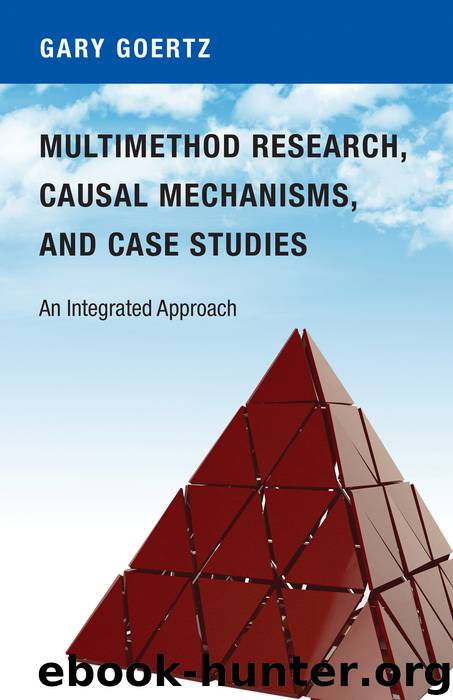Multimethod Research, Causal Mechanisms, and Case Studies by Goertz Gary

Author:Goertz, Gary
Language: eng
Format: epub
Publisher: Princeton University Press
Published: 2017-02-28T16:00:00+00:00
Constraint Causal Mechanisms Revisited
Constraint causal mechanisms often involve interactions between constraint and motivation factors. There are occasions when it makes sense to treat the motivation as given either in terms of a scope condition or for case selection, but that inevitably skews one’s view, particularly if there is significant variation on motivation.
The social movement literature provides a natural and important setting to discuss “bringing motivation back in.” The extremely influential political opportunity structure theory in all its variants is a constraint model. McAdam and Boudet’s (2012) study illustrates what it means to bring motivation into the analysis. They explore the extent to which social movements arose or not in response to proposed risky environmental projects from 2000 to 2006.
As they stress, most of the social movement literature selects on existing social movements: little is known about where, when, and why social movements arise. To constitute the universe of cases they use motivation:
At least three aspects of the project set it apart from the methodological conventions of most social movement research. First, as noted in the preceding text, we choose to study communities at risk for mobilization rather than movements per se.
Because all large, potentially controversial, infrastructure projects are required to file an EIS [Environmental Impact Statement], these records provide a population of communities at risk for mobilization. (McAdam and Boudet 2012, 25, 36)
A community enters their population of cases where there is reason to believe that the proposed project involves serious environmental risk and hence motivation for environmental groups and individuals to mobilize.
McAdam and Boudet find support for classic social movement variables including political opportunity structure (see their figure 3.1). However, they find more support for what they call “community context.” These factors include motivation. A key factor in their analysis is whether there are existing similar projects or industry in the community. For example, Louisiana is full of oil and gas projects. If the community already has such projects there might be much less motivation to protest a new one:
Residents are also acutely aware of the positive economic impact these facilities bring to the area. Several interviewees explained how the oil and gas industry is a major contributor to the Louisiana economy. Many described the industry as part of the “culture” of Louisiana, along with hunting and fishing. For example, one interviewee grew up with a gas plant in his backyard. At the time of the proposal, Cameron Parish was already home to nine pipeline processors, and nearby Calcasieu Parish housed twenty-three petrochemical facilities, which provided six thousand jobs. (McAdam and Boudet 2012, 86)
They stress that the classic political opportunity structure theory assumes that underlying motivation is present, e.g., the civil rights movement in the 1960s:
Although we have emphasized the continuity between our findings and the initial formulation of the political process model, we are nonetheless struck by an essential difference between “rights struggles” such as the civil rights movement—from which political process theory was derived—and the very different kind of conflicts that we are interrogating here. The difference concerns the causal salience of “threat” versus “opportunity” in the two types of struggles.
Download
This site does not store any files on its server. We only index and link to content provided by other sites. Please contact the content providers to delete copyright contents if any and email us, we'll remove relevant links or contents immediately.
Periodization Training for Sports by Tudor Bompa(8170)
The Body: A Guide for Occupants by Bill Bryson(4974)
The MacArthur Bible Commentary by John MacArthur(4749)
The Sports Rules Book by Human Kinetics(4294)
What It Really Takes to Get Into Ivy League and Other Highly Selective Colleges by Hughes Chuck(3696)
Marijuana Grower's Handbook by Ed Rosenthal(3622)
The Sprouting Book by Ann Wigmore(3543)
The Martian by Andy Weir(3308)
Salt, Fat, Acid, Heat: Mastering the Elements of Good Cooking by Nosrat Samin(3108)
The Bread Bible by Rose Levy Beranbaum(3004)
Harry Potter 4 - Harry Potter and The Goblet of Fire by J.K.Rowling(2990)
Sapiens and Homo Deus by Yuval Noah Harari(2987)
The Marketing Plan Handbook: Develop Big-Picture Marketing Plans for Pennies on the Dollar by Robert W. Bly(2975)
Classic by Mary Berry(2942)
Martha Stewart's Baking Handbook by Martha Stewart(2796)
Screenplay: The Foundations of Screenwriting by Syd Field(2574)
The Plant Paradox by Dr. Steven R. Gundry M.D(2547)
50 Economics Classics by Tom Butler-Bowdon(2523)
The Cambridge Grammar Of The English Language by Rodney Huddleston Geoffrey K. Pullum(2382)
